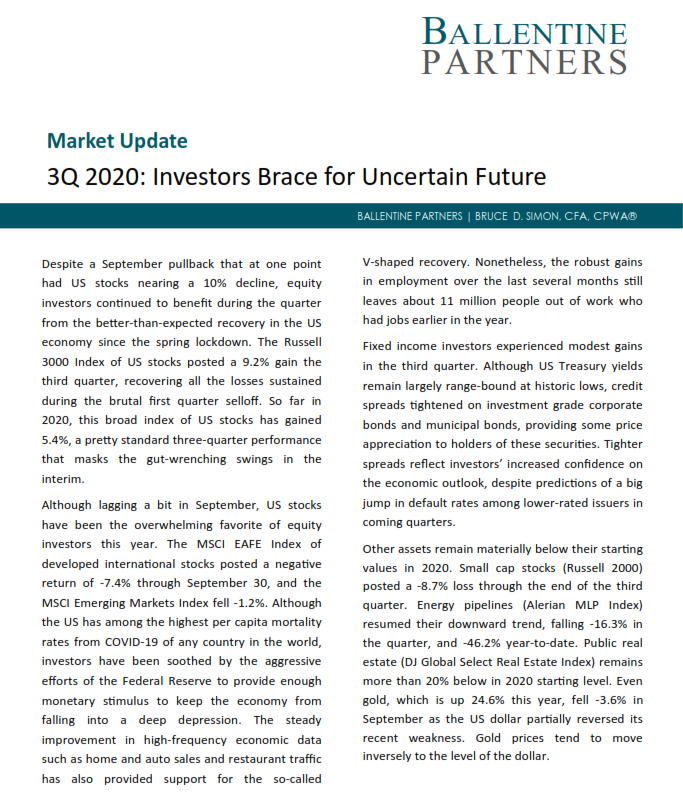Market Recap
Despite a September pullback that at one point had US stocks nearing a 10% decline, equity investors continued to benefit during the quarter from the better-than-expected recovery in the US economy since the spring lockdown. The Russell 3000 Index of US stocks posted a 9.2% gain the third quarter, recovering all the losses sustained during the brutal first quarter selloff. So far in 2020, this broad index of US stocks has gained 5.4%, a pretty standard three-quarter performance that masks the gut-wrenching swings in the interim.
Although lagging a bit in September, US stocks have been the overwhelming favorite of equity investors this year. The MSCI EAFE Index of developed international stocks posted a negative return of -7.4% through September 30, and the MSCI Emerging Markets Index fell -1.2%. Although the US has among the highest per capita mortality rates from COVID-19 of any country in the world, investors have been soothed by the aggressive efforts of the Federal Reserve to provide enough monetary stimulus to keep the economy from falling into a deep depression. The steady improvement in high-frequency economic data such as home and auto sales and restaurant traffic has also provided support for the so-called V-shaped recovery. Nonetheless, the robust gains in employment over the last several months still leaves about 11 million people out of work who had jobs earlier in the year.
Fixed income investors experienced modest gains in the third quarter. Although US Treasury yields remain largely range-bound at historic lows, credit spreads tightened on investment grade corporate bonds and municipal bonds, providing some price appreciation to holders of these securities. Tighter spreads reflect investors’ increased confidence on the economic outlook, despite predictions of a big jump in default rates among lower-rated issuers in coming quarters.
Other assets remain materially below their starting values in 2020. Small cap stocks (Russell 2000) posted a -8.7% loss through the end of the third quarter. Energy pipelines (Alerian MLP Index) resumed their downward trend, falling -16.3% in the quarter, and -46.2% year-to-date. Public real estate (DJ Global Select Real Estate Index) remains more than 20% below in 2020 starting level. Even gold, which is up 24.6% this year, fell -3.6% in September as the US dollar partially reversed its recent weakness. Gold prices tend to move inversely to the level of the dollar.
Outlook and Strategy
It is a common axiom among professional investors that markets hate uncertainty. By definition, the future is always uncertain, which is why asset prices fluctuate as new information becomes available that sheds new light on the road ahead.
As we enter the fourth quarter, the level of uncertainty facing investors is near an all-time high. On top of the stubborn persistence of the coronavirus pandemic, the unpredictable timeline of the distribution of an effective vaccine, and the stalemate over the passage of additional fiscal stimulus, we now have the additional uncertainty around the election as a result of President Trump’s illness from contracting COVID-19.
The next few months are expected to be extremely volatile as a number of these issues are clarified. Barring some major snafu in the voting process, we should know the identity of our next president and which party controls the levers of power in Washington. We should have the results of several of the Phase III vaccine trials and have a much better sense of when a drug could be broadly distributed among the world’s population. We should know whether the onset of colder weather has resulted in another upswing in infections, and what impact that will have on economic activity.
The stock market’s furious rally since mid-March implies that investors are largely expecting these issues to be resolved favorably, and we tend to agree. With Biden leading comfortably in the polls (and discounting the false signals from the polls in the last presidential election), the markets seem to be accepting of a shift in power toward the Democrats. Biden’s threat to raise taxes is a negative for investors, but if tax hikes are accompanied by a burst in government spending, the net impact may be positive for stocks.
Similarly, the all-out effort by the scientific community to develop a vaccine for coronavirus appears to be bearing fruit. Consensus expectations by informed professionals call for a reasonably effective vaccine to be widely available by the middle of next year. Restoring the global economy to its traditional growth path is critically dependent on a successful launch of a vaccine in the timeframe expected by investors in order to support the market’s current valuation levels.
Prudent application of policies developed during the pandemic (mask wearing, social distancing, etc.) should allow the US economy to sputter along during the colder months without the need for another mass lockdown, especially if further stimulus is enacted.
Of course, a significant pullback in stock prices in the next few months is quite possible if one of these conditions (or some other unknown) fails to meet market expectations. As the cloud lifts on many of these uncertainties, however, the longer-term outlook remains quite bright. Highly stimulative monetary and fiscal policies are likely to keep a solid floor under asset prices.
In times of heightened uncertainty, our approach is to remain broadly diversified so that client portfolios are not overly exposed to any one particular risk. Given our optimistic longer-term view, we would view any meaningful selloff as an opportunity to harvest tax losses and position portfolios for an expected rebound as the economy returns to form.
About Bruce D. Simon, CFA, CPWA®
Bruce is a Partner and the Director of Research at the firm. In addition to working directly with a number of family clients, Bruce serves on Ballentine’s Investment Management Committee, which is responsible for the oversight of all of the investment activities for the firm.
This report is the confidential work product of Ballentine Partners. Unauthorized distribution of this material is strictly prohibited. The information in this report is deemed to be reliable but has not been independently verified. Some of the conclusions in this report are intended to be generalizations. The specific circumstances of an individual’s situation may require advice that is different from that reflected in this report. Furthermore, the advice reflected in this report is based on our opinion, and our opinion may change as new information becomes available. Nothing in this presentation should be construed as an offer to sell or a solicitation of an offer to buy any securities. You should read the prospectus or offering memo before making any investment. You are solely responsible for any decision to invest in a private offering. The investment recommendations contained in this document may not prove to be profitable, and the actual performance of any investment may not be as favorable as the expectations that are expressed in this document. There is no guarantee that the past performance of any investment will continue in the future.




